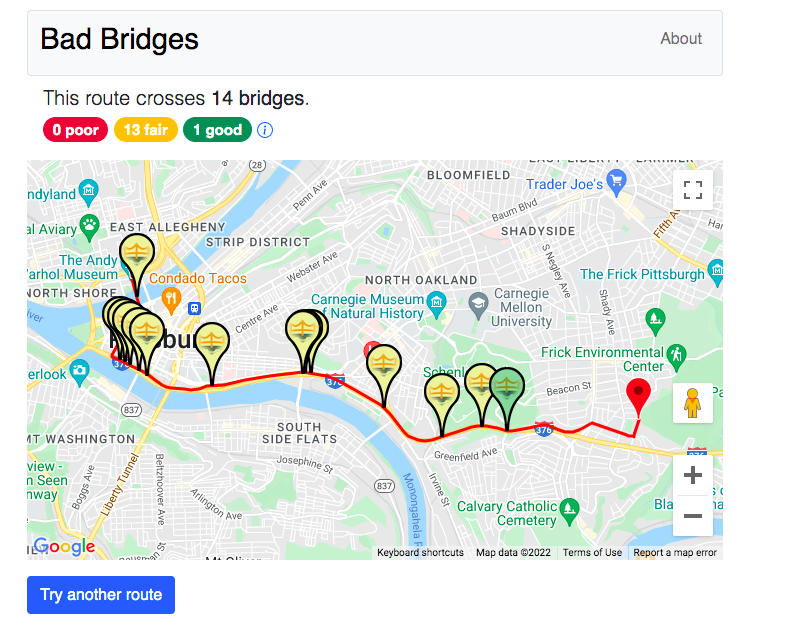After the collapse of the Fern Hollow Bridge, are you wondering what other Pittsburgh bridges might be in dire shape? Rainy Sinclair built an app for that.
The local senior software engineer set out to map all of the deteriorating bridges in the Pittsburgh region, for drivers, bikers and pedestrians to beware. The app, called Bad Bridges, allows users to input the starting point and destination of any route in Pittsburgh, and maps out the amount of bridges crossed on that route. Below the map, it lists each bridge’s condition, year built, most recent inspection date, next upcoming inspection date, length and custodian, where applicable.
http://twitter.com/ohheyitsrainy/status/1496173019718467584
The app development process was pretty simple, Sinclair told Technical.ly via Twitter.
“I used Glitch.com, which is a free site that lets you really easily create web apps that do pretty much anything you want,” they wrote. “I used Glitch because I don’t have much front-end development experience so most of my website ideas get stuck at the ‘where do I even start?’ phase. With Glitch, I was able to make the whole thing in a web browser and get something running in just a few minutes. I can even make changes to it on my phone if I want to!”
Sinclair’s not the only one using tech to attempt to resolve Pittsburgh (and America’s) infrastructure crisis. It was a hot topic during President Joe Biden’s visit to Hazelwood Green last month and is the basis of a new initiative from local Y Combinator and Technical.ly RealLIST Startup Mach9 Robotics. But Sinclair’s app is unique from those other efforts in that it provides everyday Pittsburghers with a solution right now by giving them access to a citizen-built platform.
It’s also a prime example of the power open data can have. Sinclair inputted data from a list of all the bridges in Pennsylvania provided by the Pennsylvania Department of Transportation (PennDOT). From there, they filtered the list for bridges located in Allegheny County and parsed other filters provided by the database’s documentation.
For the mapping functions, Sinclair used Google APIs to provide the route determination and address auto-filling. Because of that though, it can make the occasional mistake.
“It grabs the directions from Google and then checks along the route to see which bridges it crosses (or comes close to crossing) based on latitude/longitude,” Sinclair wrote. “It’s not perfect; the downtown area especially gets tricky because there are SO many bridges so close together, so it does its best to guess which ones you are on, but might not be 100% accurate.”
Since launching the app last week, it’s grown in popularity on Twitter, with other local technologists pitching in recommendations for various improvements. Sinclair said they’d taken some of those suggestions to modify the app, but overall, hasn’t spent too much more time improving it, since it’s a side project to their full-time job at an internet infrastructure company.
This isn’t the first citizen tech project Sinclair’s pursued. They’ve developed platforms for mushroom identification, Arduino-driven LED light installations, programming for escape rooms and more. But the Bad Bridges app is the first time they’ve used civic data for a tech project. Why the change up?
“My main motivation was to be able to connect the issue of our eroding infrastructure to my personal life in a way that feels a bit more meaningful and useful,” Sinclair said. “I think exploring the PennDOT data in this way really helps to personalize the problem and can help folks understand the potential impact that bridge safety has on their day-to-day life.”







